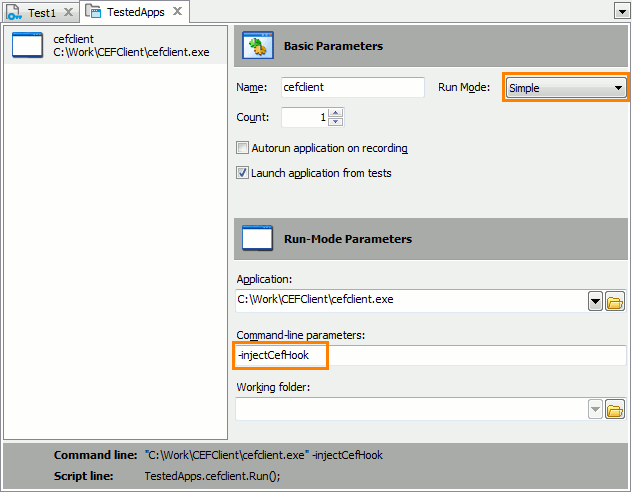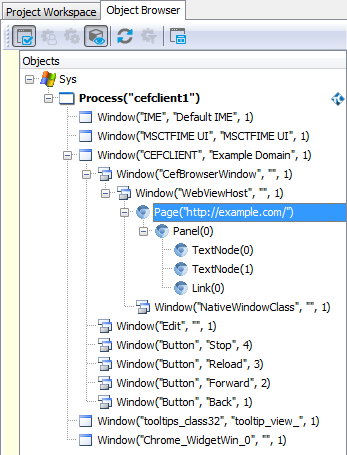TestComplete can access web pages in applications based on the Chromium Embedded Framework (CEF). Before you can test CEF applications, you need to prepare your TestComplete project or tested application.
Instrument CEF Application
Option 1: Automatic Instrumentation (Recommended)
TestComplete can automatically expose elements in CEF-based applications. To enable this, add your application to the Tested Applications collection and launch it in Simple run mode while one of the following conditions is met:
- The application’s executable imports the libcef.dll library.
— or —
- The libcef.dll library and the application’s executable are located in the same folder.
— or —
- The application has the
injectCefHookcommand-line argument (in any letter case and with any prefix).
This is the recommended way to work with CEF-based applications.
Option 2: Compile Application With TestComplete Library
Another way to enable CEF applications for testing is to compile the application with the TestComplete tcCEFHook library. You need to do this, for example, if you start your application outside of TestComplete, or run it in RunAs, Debug, or Profile run mode.
The tcCEFHook library path is:
-
For 32-bit CEF-based applications: <TestComplete>\Bin\Extensions\tcCEFHook.dll
-
For 64-bit CEF-based applications: <TestComplete>\x64\Bin\Extensions\tcCEFHook.dll
You can copy the tcCEFHook library to your application’s folder, or open it from the original location.
Change your application’s code as follows:
-
Insert instructions that load the tcCEFHook library before the
cef_initialize()function that initializes CEF.C++
...
// Load the TestComplete automation library
HMODULE tcHook = LoadLibraryW(L"tcCEFHook.dll");
...
// Initialize CEF
CefInitialize(settings, app);Delphi
...
// Load the TestComplete automation library
TCDLLHandle := LoadLibrary(PChar('tcCEFHook.dll'));
...
// Initialize CEF
TChromium.Create(Parent);C# CefSharp
...
using System.Runtime.InteropServices;
...
// Import LoadLibrary and FreeLibrary methods from kernel32.dll
[DllImport("kernel32.dll", CallingConvention = CallingConvention.Winapi)]
static extern IntPtr LoadLibrary(string lpFileName);
[DllImport("kernel32.dll", CallingConvention = CallingConvention.Winapi)]
static extern bool FreeLibrary(IntPtr hModule);
...
// Load the TestComplete automation library
IntPtr tcModulePtr = LoadLibrary("tcCEFHook.dll");
...
// Initialize CEF
CEF.Initialize(cefSettings);Java
...
// Load the TestComplete automation library
System.load("tcCEFHook.dll");
...
// Initialize CEF
c = new Chromium(composite1, SWT.NONE, "google.com"); -
Add code that unloads the tcCEFHook library after the
cef_shutdown()function that shuts down CEF.C++
...
// Shut down CEF
CefShutdown();
// Release the TestComplete automation library
if (tcHook)
FreeLibrary(tcHook);
...Delphi
procedure TFormMain.FormClose(Sender: TObject; var Action: TCloseAction);
begin
//Release the TestComplete automation library
if TCDLLHandle>=32 then
FreeLibrary(TCDLLHandle);
end;C# CefSharp
...
// Shut down CEF
if (CEF.IsInitialized)
CEF.Shutdown();
// Release the TestComplete automation library
if (tcModulePtr != IntPtr.Zero)
FreeLibrary(tcModulePtr);
...Java
// Library is automatically released by garbage collector
Note: The exact names of wrapper functions that correspond to CEF’s cef_initialize() and cef_shutdown() functions may vary depending on the programming language and framework used. For example:
- C and C++ –
CefInitialize()andCefShutdown() - Java –
CefApp.getInstance()andCefApp.dispose() - CefSharp –
CEF.Initialize()andCEF.Shutdown() - and so on.
Disable Windows (Off-Screen) Rendering
A CEF application can use windowed or windowless (off-screen) rendering. TestComplete supports CEF applications that use windowed rendering. Windowless (off-screen) rendering mode is supported only for WPF components of the CefSharp framework. Other applications that use windowless rendering are not supported. If your application uses windowless rendering, you need to disable it for testing purposes.
The way you disable windowless rendering depends on the programming language and framework used. Refer to the documentation of your CEF framework for details.
Verify CEF Support
Start your tested application (for example, from TestedApps) and switch to the Object Browser. You should see the Page object in your application. You can use it to automate web pages and web page elements in the application’s embedded web browser.

See Also
Support for Chromium Embedded Framework
About Support for Chromium Embedded Framework
Web and RIA Testing
Requirements for Web Testing

 Instrument CEF Application
Instrument CEF Application